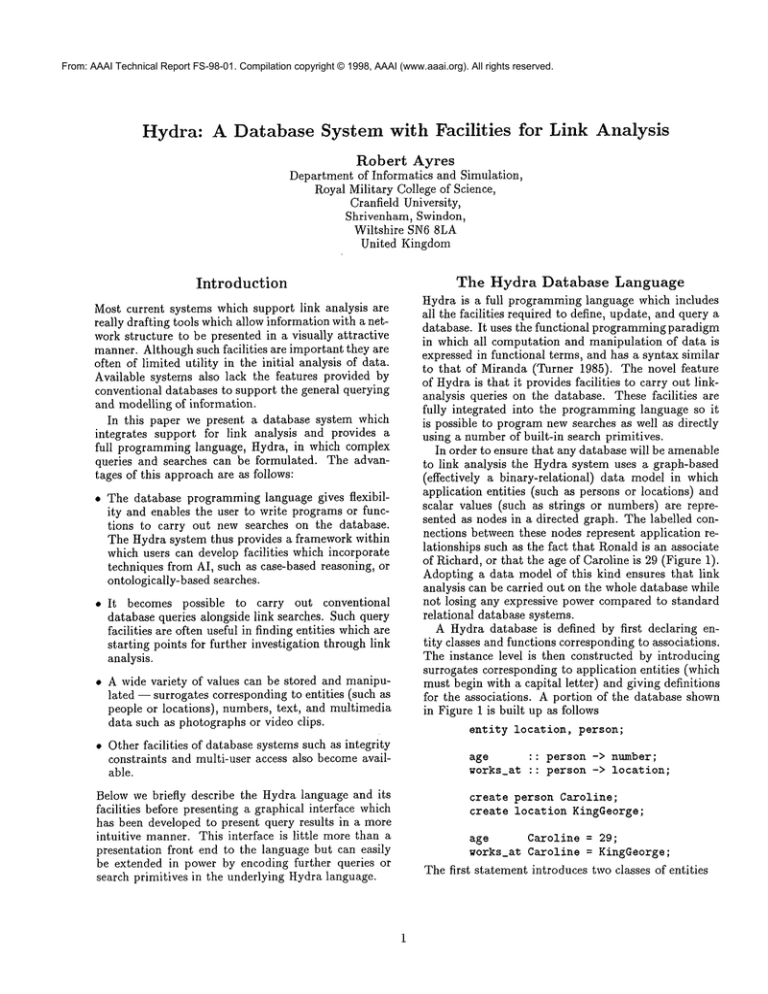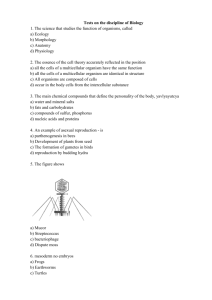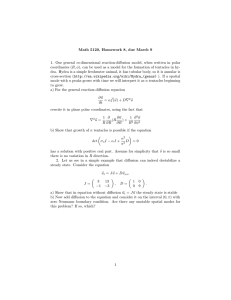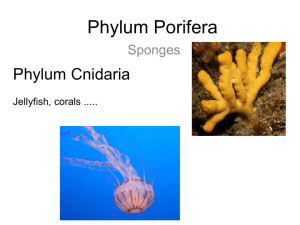
From: AAAI Technical Report FS-98-01. Compilation copyright © 1998, AAAI (www.aaai.org). All rights reserved.
Hydra: A Database System with Facilities
for Link Analysis
Robert
Ayres
Department of Informaties and Simulation,
Royal Military College of Science,
Cranfield University,
Shrivenham, Swindon,
Wiltshire SN6 8LA
United Kingdom
Introduction
Most current systems which support link analysis are
really drafting tools which allow information with a network structure to be presented in a visually attractive
manner. Although such facilities are important they are
often of limited utility in the initial analysis of data.
Available systems also lack the features provided by
conventional databases to support the general querying
and modelling of information.
In this paper we present a database system which
integrates support for link analysis and provides a
full programming language, Hydra, in which complex
queries and searches can be formulated. The advantages of this approach are as follows:
¯ The database programming language gives flexibility and enables the user to write programs or functions to carry out new searches on the database.
The Hydra system thus provides a framework within
which users can develop facilities which incorporate
techniques from AI, such as case-based reasoning, or
ontologically-based searches.
¯ It becomes possible to carry out conventional
database queries alongside link searches. Such query
facilities are often useful in finding entities whichare
starting points for further investigation through link
analysis.
¯ A wide variety of values can be stored and manipulated -- surrogates corresponding to entities (such as
people or locations), numbers, text, and multimedia
data such as photographs or video clips.
¯ Other facilities of database systems such as integrity
constraints and multi-user access also becomeavailable.
Below we briefly describe the Hydra language and its
facilities before presenting a graphical interface which
has been developed to present query results in a more
intuitive manner. This interface is little more than a
presentation front end to the language but can easily
be extended in power by encoding further queries or
search primitives in the underlying Hydra language.
The Hydra
Database
Language
Hydra is a full programming language which includes
all the facilities required to define, update, and query a
database. It uses the functional programmingparadigm
in which all computation and manipulation of data is
expressed in functional terms, and has a syntax similar
to that of Miranda (Turner 1985). The novel feature
of Hydrais that it provides facilities to carry out linkanalysis queries on the database. These facilities are
fully integrated into the programming language so it
is possible to program new searches as well as directly
using a numberof built-in search primitives.
In order to ensure that any database will be amenable
to link analysis the Hydra system uses a graph-based
(effectively a binary-relational)
data model in which
application entities (such as persons or locations) and
scalar values (such as strings or numbers) are represented as nodes in a directed graph. The labelled connections between these nodes represent application relationships such as the fact that Ronald is an associate
of Richard, or that the age of Caroline is 29 (Figure 1).
Adopting a data model of this kind ensures that link
analysis can be carried out on the whole database while
not losing any expressive power compared to standard
relational database systems.
A Hydra database is defined by first declaring entity classes and functions corresponding to associations.
The instance level is then constructed by introducing
surrogates corresponding to application entities (which
must begin with a capital letter) and giving definitions
for the associations. A portion of the database shown
in Figure 1 is built up as follows
entitylocation,person;
age
:: person-> number;
works_at:: person-> location;
createpersonCaroline;
create locationKingGeorge;
age
Caroline= 29;
works_atCaroline= KingGeorge;
The first statementintroduces two classes ofentities
age
phone
_ RonsGym
~---7/%
"03456 123456"
/
~°°-
\~
~ "x,~equents
/
7address/
works_at
/~
.. /
~ ~
"~’
~ Peter
34 ~
"03456
/
ass°cla
ph°ne
/
~_
~
111222"
x~
~ associate
.
/
works_at
~ Sean
/
\/
"MarketSquare, Littletown, Middx"
Figure1: Instance-Levelof a CriminalIntelligence Database
.!
C:
~
It
:~
~
rna/noffit~
D~
Mm’t/aWts~
trades ~t
~ "rae~
/oea=mb
Va~’~t~
trad/ng name
"]eMart
~ Lta"
?
Figure 2: Portion of Database and subwindowwith Information on JoMartEnts
(location and person); the following two statements
declare the associations age and works at and specify
what kinds of value they can associate with each other.
Twoentities, represented by visible surrogates, are then
introduced before defining someassociations.
Hydra is a full programming language and so, unlike SQL, can be used as a general purpose programming system (though its main purpose is to enable users
to express database queries). A conventional database
query to find all men knownto be under 30 can be made
using a list abstraction (a standard construct in functional languages which is similar to the Zermelo-Frankel
notation of set theory) as follows:
[In ] m <- like ?person
I sex m == "male"I age m < 30];
which can be paraphrased as Return a list of all the m
such that m is a person, the sex of m is "male" and
the age of m is less than 30. This will evaluate to the
single-itemed list
[Richard]
Other queries, corresponding to the "select-projectjoin" style queries of SQLcan easily be encoded using
list-abstractions.
To find all the associations in whicha value or entity
mayparticipate, one of the special link-oriented primitives is used as follows
from Susan;
This returns the list
[associate,works_at,frequents,
age, address,phone]
of all the associations defined on a person. Anyof these
associations can be used as a function and applied to
the surrogate Susan. For instance
works_at Susan;
gives a list
[SmallBillsGarage]
of the locations where Susan works. Another built-in
function, to, provides similar facilities to from but finds
inverse associations. For example
to 29 ;
returns a list
[’age]
of inverse associations (whose names are prefixed with
a tilde). Inverse associations correspond to following
the directed arcs in the database graph "backwards".
Applying the inverse function "age to a number will
find all the people with that age, so
-age 29;
gives the list
[Richard,Caroline]
of 29-year
oldsin thedatabase.
Theuseof thesetwo
built-in primitives can be combined to find everything
knownabout a value or entity. For example
[(f,
f Richard)l f <- append(from Richard)
(to Richard)
I f Richard!= [] ];
findsallthedatabase
functions
whichcanbe applied
to Richard
(append
is a function
to jointwoliststogether),
filters
outthosethatgivean emptyresult,
and
returns
a listofpairsoftheremaining
functions
andthe
resulttheygivewhenapplied
to Richard.
Thiseffectively
gives all the information directly associated with
Richard in the database
[(age,[29]),(sex ["male"l),
(frequents,
[KingGeorge]
),
(associate,
[Ronald])]
Thisfacility
to findeverything
knownaboutan entity
can be generalised to a function known,defined as follows
known x = [(f,f x) l f <- append(from
(tox)
I f x != []];
Hence the expression known Richard will evaluate to
the same result as the previous query. The function
knownhas been defined in terms of the primitives from
and to and provides a facility, that of finding all the
information associated with an entity or value, which
is not available in conventional systems. Indeed such
facilities cannot be integrated into relational or objectoriented databases because these systems use data models which do not explicitly represent all the connections between database entities or values. Furthermore
queries such as Find everything known about Richard
are second order and cannot be replicated in standard
database query languages which are limited to first order queries.
Another Hydra primitive trailcan be used to find
the connection between two database values or entities
(if there is one). For example the query
trail 1 RichardKingGeorge;
willfindanydirectconnections
betweenRichardand
the KingGeorge pub, returning the answer as a list of
paths (each path represented as a sequence of nodes
and links) as follows
[[Richard,frequents,KingGeorge]]
A searchforlongerconnections
canbe carried
outby
giving a larger search depth, as in
trail 3 Peter KingGeorge;
which will return the two paths
[[Peter,associate,Sean, "associate,
Caroline,works_at,KingGeorge],
[Peter,associate,Sean,
frequents,KingGeorge]
]
The trail primitive is built into the Hydra language
for efficiency reasons (it could be programmedin terms
of the primitives from and to but the searching would
then be slower). The trail primitive automatically discards paths which contain loops or which pass through
a scalar value (eg. a string or number). Scalar values
|-
Figure 3: Canvas Showing Menuof Items Associated with Each of 3 Selected Iacidents
can appear at the ends of paths but are excluded from
mid-points since there would be the danger of retrieving
paths of the form
[Bill,sex, "male", "sex, John]
whichare of little interest.
Given that the primitives from and to can be embedded into ordinary Hydra function definitions it is
possible to program complex searches. For example it
is relatively simple to develop a Hydra function centre
which will take a search depth, a list of start nodes,
and return a list of nodes which all within the search
distance of each of the start nodes. Hence, given the
database shown in Figure 1, the query
centre2 [KingGeorge,
29, Susan];
will return the list
[Ronald,Sean]
of items which are all within 2 arcs distance of each of
the three nodes in the original query. The centre function can be used to find a commonassociation between
a group of elements and can be enhanced to find the
node which is, in aggregate, most closely connected to
the start nodes. An example of the use of centre will
be given in the next section.
Far more complex queries and functions can be coded
in Hydra and any computable search algorithm can be
implementedusing its link-finding primitives.
A Graphical
Interface
For most users the Hydra language has a number of
drawbacks: it assumes a familiarity with functional programming and the results from queries, such as pathfinding queries, are presented in a form which obscures
the relationships which have been found. Furthermore
a purely textual interface hinders the use of multimedia
datatypes. These problems have motivated the development of a prototype graphical interface to the language.
This interface exploits the graph-based data model to
present data on a free-form canvas where both the connections modelled by the database and multimedia data
can be incorporated (see Figure 2).
The Hydrainterface initially provides the user with a
blank canvas on which entities or values can be placed
by clicking with a mouseand typing in the value or entity identifier. If the value or entity is present in the
database a node will be placed on the canvas. Icons
are used to represent entities, and the particular icon
to use for any given entity is itself information which
is held in the database. For example in Figure 2 a
portion of a criminal intelligence database is shown
where running-man icons are used to represent incident entities (that is recorded incidents such as robberies, or assaults), wine-bottle icons for nightclubs,
man-at-desk icon for a business and so on. A question
mark is drawn on the canvas next to those items or
values which have further information associated with
them which is not shown on the canvas. Once an entity or value has been placed on the canvas, doubleclicking on it brings up a sub-window which shows everything known about the item. In Figure 2 the user
has double-clicked on the JoSartEnts entity and everything knownabout the entity, which is a nightclub
business, is shownin the sub-window(items in the subwindow which are already on the canvas are prefixed
by ***). This information has been obtained by sending the query known JoMartEnts to the underlying
Hydra database (making use of the knownfunction described in the previous section). It is possible to select
entities or values in the sub-windowand place them on
the canvas, at which point the interface also draws in
the connecting arc. The user can drag items on the
canvas to produce a more pleasing or intuitive layout
than that produced by the interface’s drawing routines.
Figure 2 actually shows a portion of an intelligence
database where an investigating officer has started out
by looking into a numberof incidents where creosote has
been used to vandalise premises. Having first placed
the value "creosote" on the canvas the officer has
then found that there have been three such incidents:
Inc089, Inc072, and Incl07. A description of an unknown person, Sus089a, involved in incident Inc089a
has been used to find an individual, RussellFuller, already in the database whose details are consistent with
those of Sus089a.
In Figure 2 the user has also uncovered a connection
between the incidents: they have all involved nightclubs
run by the same company. This connection was found
by using one of the facilities of the interface, centre.
Howthis was done can be seen from a previous screen
view, shown in Figure 3, where the user has selected
three incidents (shown with target signs next to them)
and used the centre facility on the left of the menubar.
This invokes the centre function described in the previous section and returns a menuof of "central" nodes
(Figure 3). The user has selected the JobfartEnts entity
and this has been placed on the canvas and its associations with other nodes drawn in to produce the state
shown in Figure 2.
It is also possible to invoke the trail facility from
the interface.
Returning to Figure 2 the user has
found a connection between the three incidents (they
are all associated with JoMartEnts)
and also discovered that a person whose details are already known,
Russ ellFull er, has a description consistent with a suspect in one of the incidents. The obvious question to
ask is whether RussellFuller
has a connection with
JoblartEnts -- might he be a disaffected former employee for example? If a connection does exist in the
data it it can be found by selecting these two entities
(by clicking on them) and invoking the trail facility
the menu bar. This sends a trail query to the underlying Hydra database and the results are drawn on the
canvas. Figure 4 shows the situation after this has been
done and the user has further requested information on
intermediate entities along the path uncovered.
Figure 4: Database ViewshowingAssociation between JoMartEntsand l~usselFuller
Looking at this it appears that RussellFuller
may
have been hired, through intermediaries,
to attack
MartinWise and his business interests after the latter
was involved in an altercation in a nightclub. Of course
the connections uncovered do not in any way constitute evidence but they suggest a line of enquiry for the
investigating officer.
Conclusion
The Hydra system demonstrates how an appropriate
data model, combined with a small set of special linkoriented features, and a general purpose query language
make it possible to develop a powerful system in which
complexsearches can be coded and in which it is possible to experiment with various AI technologies such as
case-based reasoning.
Moreover these facilities
can be made available
through a graphical interface to users whodo not need
to master any programming language. The interface
presented is quite generic in that it does no more
than send queries (whose parameters are selected with
mouse-clicks) to the Hydra system and format the results graphically. Thus the interface is easily extensible
to accommodatea wide variety of search facilities once
these have been coded in the Hydra language.
The Hydra system and associated interface are still
under development. Future research avenues to explore
include supporting certainty measures or weightings on
the database associations and extending the graphical interface to makeit more flexible and to allow the
database to be defined and updated graphically as well
as queried.
References
Turner, D. A. 1985. Miranda: a non-strict functional
language with polymorphic types. In J. P. Jouannaud,
editor, Functional Programming Languages and Computer Architectures. Springer-Verlag. Lecture Notes in
Computer Science No. 201.






